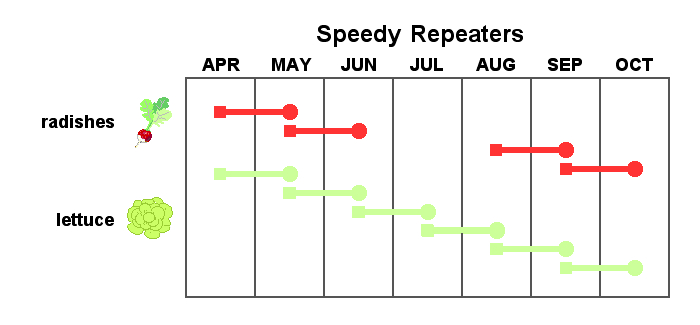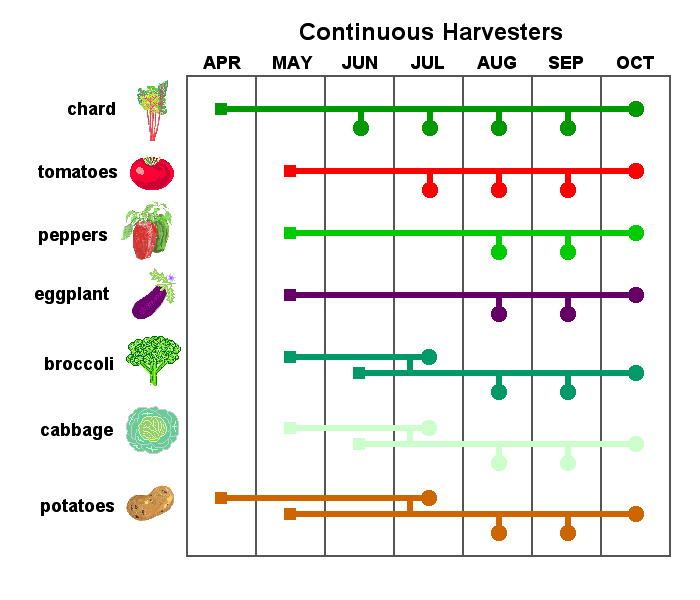Planting and Harvesting Patterns and Timelines
It's easy to think of the garden only at harvest time, but there is much to learn about the garden's seasonal cycle. Here in Eastern Massachusetts, most garden vegetables are grown between the last frost of spring and the first frost of fall. So our garden season is primarily from April through October, just seven months of the year, where in more southern states growing seasons can be much longer, sometimes the whole year long.
Seeds vs. Seedlings
To get the most from New England's short growing season, some vegetables need to be started indoors. This can be done in a greenhouse or under artificial lights. The seeds are planted in individual pots or packs of six and kept warm enough to get a head-start on the season. Seedlings can also be used to get the most out of a small garden space, transferring seedlings grown elsewhere into the garden instead of seeds.
Climate Zones
Since a garden's growing season varies with its location, climate zone maps have been developed to help gardeners figure out when to plant different crops. You can also use these maps to tell which trees, shrubs and perennial flowers can be grown in different places. You can look at a climate zone map of the United States here.
Another kind of map, called heat zone maps, divide the country into regions according to how many really hot days there are each growing season. Some plants can tolerate only a few really hot days. Others can tolerate many. You can learn more about heat zone maps here.
The charts below show the planting and harvesting patterns for some common garden vegetables in our climate zone. We'll start with the most simple pattern — one in which a veggie is planted just once and harvested just once. We'll end with the most complicated pattern — one where veggies are planted multiple times and harvested multiple times, pretty much on a continous basis.
As you look through the charts, you'll also notice a big overall pattern, one that's pretty obvious once you think about it. It's that, as the garden season begins, most of the work to be done involves planting. In the middle of the season there is both planting and harvesting to do. At the end of the season, most of the work is harvesting.
1-Timers
Peas have the simplest pattern. You plant them once and you harvest them once. It can't get much simpler than that.

Peas are also one of the first veggies to be planted. They like the fresh breezes of spring. But by the beginning of summer, they're pretty much done.
Speedy Repeaters
Moving up in complexity, the next pattern belongs to the repeaters. Repeaters copy the 1-timers in their basic one planting leads to one harvest pattern. The difference for them is that they do this more than once. Some do it twice; some, as many as five or six times.
We've divided the repeaters into two groups: the speedy repeaters — because they move from planting to harvest so quickly — and regular repeaters.

Radishes and lettuce are the speedy repeaters. Their seeds go into the ground one month and — shazam! — a month later they're ready to harvest. Radishes do their repeating with a break for the hot days of summer. Lettuce performs its repeating act all season long.
Just looking at them, you'd think it would be the other way around, wouldn't. Most kinds of lettuce seem quite delicate, where radishes look tough and sturdy like little red and white marbles. But it's the lettuce plants that "Just do it" and march their way through those hot summer months. And it's the radishes that take a break for a while.
Regular repeaters
Beets, bush beans, cucumbers, squash, and soybeans are all regular repeaters. Most of these take about twice as long as radishes and lettuce to make it from planting to harvest. Soybeans are the real slowpokes. They take three times as long!

As you can see in the chart, the regular repeaters also differ from one another in the types of climate they most prefer. Beets are the most tolerant. They'll grow all season long. Cucumbers and squash have the smallest growing window. They're happy just June through September.
Continuous Harvesters
Continuous harvesters move us up still another level of complexity in the vegetables' planting and harvesting patterns. Plants in this group don't have one single harvesting window, like the others we've already talked about. Once they've made it through their initial period of growth, these plants can be harvested pretty much on a continuous basis.
As you can see from the chart below, leafy, deep-green chard is the endurance champion of the continuous harvesters. It plants the earliest; it's ready for harvesting the soonest; and it keeps going strong the full season. (By the way, it's also very good for you. It's full of important vitamins and minerals.)
Tomatoes, peppers, and eggplant are also continuous harvesters. All three go into the ground in May and are then ready for picking from July or August to the end of the growing season.

The final three plants in this group add one last bit of complexity to the continuous harvester growing pattern. That's the fact that they can also be planted over multiple months. Each has at least three months available for planting and four months available for harvesting.
Month-by-month patterns
Remember the point we made earlier about how work patterns change over the course of a garden's growing season? We said lots of planting up front, lots of harvesting at the end, and a mix of the two in between. Here's what that overall pattern would look like for the veggies we discussed here.

Can you see the rise and fall for planting and the rise and fall for harvesting? Have you ever ridden a roller coaster? Can you see the roller coaster here? Sometimes growing a garden is like riding a roller coaster. There's so much going on, so much to do, so many decisions and adjustments to make. There are also big ups and, sometimes, big downs. It can be full of challenges and adventure.
~ :: ~
Just step back for a moment and think about all the different growing patterns we discussed for these different vegetables. It's close to impossible to keep them all in your head at once, isn't it. That's why planting and growing a garden requires a lot of careful planning. It's a big responsibility. It's not quite rocket science; but it certainly edges in that direction.
Yet lots of regular, next door kinds of people plant and cultivate beautiful gardens of their own every year. It's something that you could do some day, too — something maybe you ought to consider trying your hand at some day.


